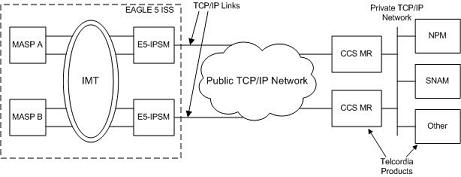| Oracle® Communications EAGLE Database Administration - System Management User's Guide Release 46.6 E93319 Revision 1 |
|
 Previous |
 Next |
| Oracle® Communications EAGLE Database Administration - System Management User's Guide Release 46.6 E93319 Revision 1 |
|
 Previous |
 Next |
The SEAS over IP feature is a TCP/IP-based interface for SEAS that creates a path between the EAGLE and the CCS MR (Common Channel Signaling Message Router). The CCS MR is a stand-alone, self-contained system developed by Telcordia that provides a centralized mechanism for routing CCS network operations traffic between STPs/SCPs and existing and new OSs.
One of the eight telnet terminals on the E5-IPSM is used to provide the connection from the EAGLE and the CCS MR. This terminal is referred to as a SEAS terminal.
Note:
As of Release 46.5, the E5-IPSM card and its functionality is replaced by the E5-ENET-B (p/n 870-2971-01) or SLIC (p/n 7094646) card. Any references to E5-IPSM and the 870-2877-01 part number should be replaced by the 46.5 and greater card and part number.The EAGLE can contain a maximum of two SEAS terminals. Only one SEAS terminal can be assigned to an E5-IPSM. The remaining seven telnet terminals on the E5-IPSM continue to provide generic IP-based services such as Telnet and FTP.
SEAS over IP Feature Configurations
The SEAS over IP feature supports three configurations"
Dual SEAS Terminals with a Single CCS MR SEAS Configuration
The two SEAS terminals are connected to a single CCS MR as shown in Figure 5-1. The two SEAS terminals operate in a redundant fashion allowing a maximum of two active connections to the CCS MR. While the connection to the CCS MR is dedicated to SEAS, the other terminals on the E5-IPSM may still be used for other IP-based operations, such as Telnet and FTP, or their secure counterparts, SSH and SFTP. Different SEAS information can be transmitted and received separately over each connection to the CCS MR.
Figure 5-1 Dual SEAS Terminals with Single CCS MR SEAS Configuration

Dual SEAS Terminals with Dual CCS MRs SEAS Configuration
When the two SEAS terminals are connected to two CCS MRs, as shown in Figure 5-2, the operation of the SEAS connections is similar to the "Dual SEAS Terminals with a Single CCS MR SEAS Configuration" section with the following exceptions:
Figure 5-2 Dual SEAS Terminals with Dual CCS MRs SEAS Configuration

Simplex SEAS Terminal Operation
With the simplex SEAS terminal operation, there is only one SEAS terminal connected to one CCS MR. There are no redundant connections to the CCS MR and this configuration is intended to serve as a restricted mode of operation until another SEAS terminal is returned to service. The simplex mode of operation is not recommended as a standard mode of operation for the SEAS over IP feature.
Figure 5-3 Simplex SEAS Terminal Configuration

Provisioning the SEAS over IP Feature
To provision the SEAS over IP feature, perform these steps.
ent-card command. Perform the Adding an E5-IPSM procedure.enable-ctrl-feat command. Perform the Activating the SEAS over IP Feature procedure.chg-seas-config command. Perform the Performing the Initial SEAS Configuration procedure.chg-trm command. Perform the Configuring SEAS Terminals procedure.chg-ctrl-feat command. Perform the Activating the SEAS over IP Feature procedure.